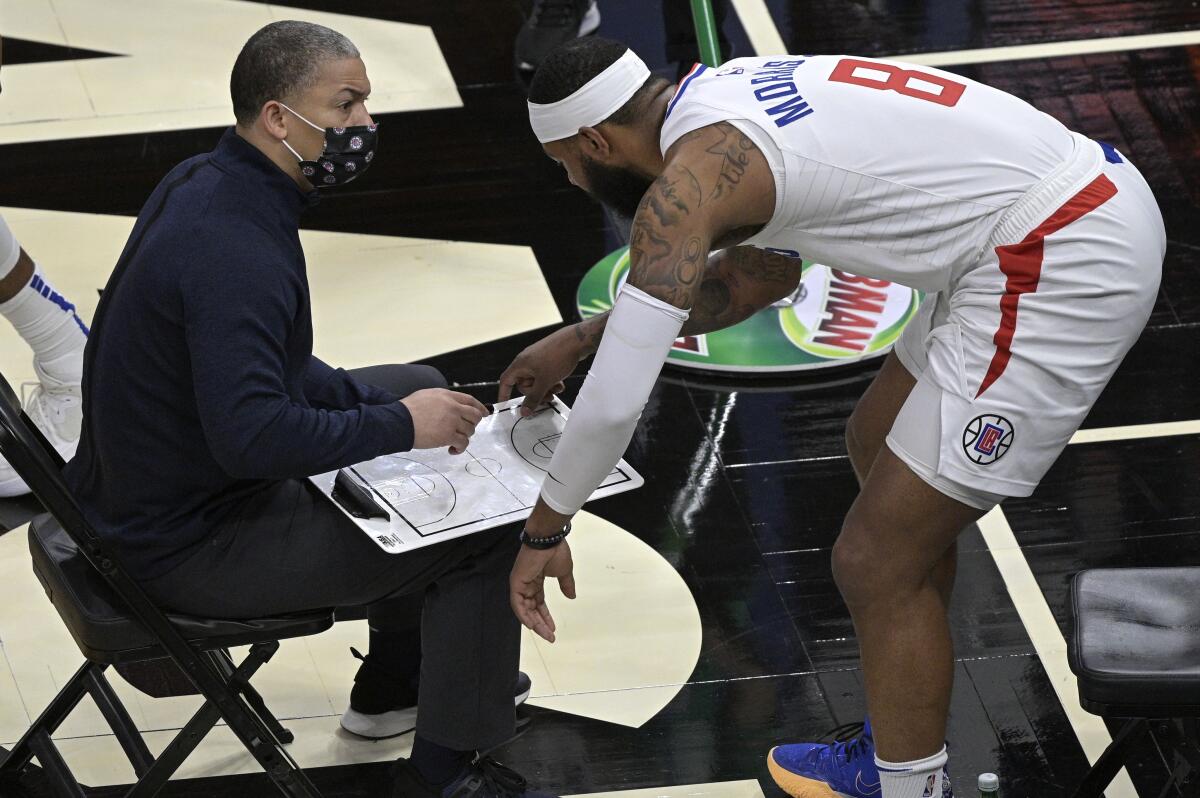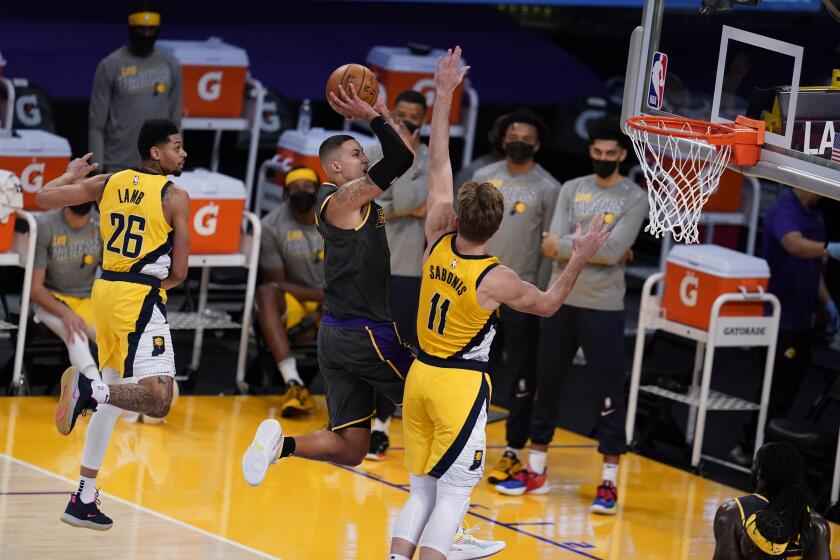Why the pandemic has virtually killed practices in the NBA

- Share via
The black mask covering Clippers coach Tyronn Lue’s mouth jumped as his eyes opened wide, the question so ridiculous and the answer so obvious that he couldn’t keep himself from cracking up.
“How different are the practices you participated in as a first-year player in Los Angeles from the ones you’re running now in your first year as Clippers coach?” the reporter asked.
“You trying to get me in trouble?” Lue asked while laughing and repeating himself with a little more emphasis. “You trying to get me in trouble, man?”
He laughed because the answer is no secret. Phoenix guard Chris Paul laughed when asked the same thing. Clippers star Paul George too. Times have changed.
Say the word “practice” to an NBA player, coach or executive in 2021 and you’ll either get a chuckle or an Allen Iverson impression. If leaguewide trends had not already devalued the thing that makes one perfect, the NBA’s pandemic schedule has almost eliminated it.
Say it to someone like Kurt Rambis, and you’ll hear them laugh too. The former Lakers player and coach and current team executive was running some of those practices that Lue was talking about.
As a player, practices with the Lakers were brutal for Rambis, the whistle almost always swallowed and the work seemingly unending.
“The concept and the premise was that practice was supposed to be harder than the game so the game would be easier,” he said. “… Fouls were rarely called. You just had to learn how to keep playing and absorb things and when you got into the game, things would be easier.”
With improved medical information, scientific advancements and increased financial investment, priorities have changed. The goal is to make it to the end of the season healthy. Practices, especially the full-contact ones, might not be worth the injury risk.
There’s a cost. Some in the NBA point to the decrease in practice as a reason why games sometimes look so rocky, and to an extent look so individual. Defensive schemes that can become increasingly sophisticated in the postseason don’t get the same attention without frequent on-court team workouts in the regular season.
The shutdown of the NBA because of the COVID-19 pandemic forced teams to adapt innovative ways to conduct business. A look at some of those changes.
Coaches and players have had to adjust and adapt to new ways to stay sharp as the perceived value of traditional practice continues to erode.
The Lakers, the league’s defending champions, held only five practices between the start of the season and the All-Star break. Following a rare span in which the team practiced two times in three days, the Lakers have only four more instances on their schedule with two days off between games.
“I definitely do,” coach Frank Vogel said when asked if he wished the Lakers practiced more. “I think the execution suffers when you can’t get reps in to work on your habits. And I’ve felt that with our team.”
Vogel has seen it hurt his team in all aspects, including the ability to execute and play in rhythm off of one another, but said he’s seen it most in transition defense.
He’s not the only one feeling it. The Clippers have held only seven formal practices this season, like so many other teams in the NBA, saving their best for later.
“We use the games as practice,” Brooklyn’s James Harden said before the All-Star game. “… The most important thing is being ready once the postseason starts.”
While coaches would almost unanimously agree that practice is the best way to ensure that a team is at peak functionality come playoff time, there are too many other factors that organizations value.
Former coach Jeff Van Gundy, one of the league’s most audible voices thanks to national broadcasts on ESPN and ABC, has seen how practices have changed since he led the New York Knicks 25 years ago.
While there’s a bit of a “in my day, we used to have to walk to school uphill both ways” quality in comparing eras, they are drastically different.
“More time spent on the floor, more time, with more contact, and more repetitions. And it was more competitive,” Van Gundy said of the old way to practice. “It wasn’t just five-on-zero. It was more drill work and more physical competition, you know? Yeah, I mean, it was just more. More would be the word. More often. Longer. More competitive.”
Van Gundy said his practices could be as much as 40% live action. That’s the kind of work where players “make sure your ankles were taped,” as Washington Wizards All-Star Bradley Beal described it, which just doesn’t happen as often anymore.
The major reasons why teams don’t practice as often are tied to player safety with an increased emphasis on health and recovery by keeping teams off the court on days they don’t play.
The Lakers’ practice formula this season has been to hold one only if there are two days off between games. Teams almost never practice after back-to-back games and fewer teams are holding workouts if there’s only one day off between games.
“We play every other day,” Beal said. “You have to ask yourself, ‘When do we have time to practice?’”
With schedules crunched even tighter because of the pandemic-compressed offseason and 72-game schedule, teams have been forced to re-evaluate how they handle their time.
The Lakers have been very good at taking lengthy film sessions and converting them into on-court strategies. Utah has taken individual skill work and put players into small groups in an effort to get them even more connected. Philadelphia has considered combining practices and shootarounds into some sort of late-afternoon combo on the day before a game.
The Lakers were missing two starters Friday and lost a key reserve to injury, but Kyle Kuzma answers the call in 105-100 defeat of Indiana Pacers.
Coaches believe the easiest way to improve a team is by repeating principles and assignments in practice settings, making those actions and reactions second nature through repetition.
“How do the quality repetitions turn into habits because at the end of the day, you are your habits,” Van Gundy said. “And you have to have better habits than the people that you play against.”
With strict daily testing routines and a world full of stressors escalated by the pandemic, coaches are wrestling with how much they should expect to get out of a practice if they hold one.
“I felt like the emotional endurance and the mental capacity of your team given the situation is just different,” Jazz coach Quin Snyder said.
That the Lakers have been able to be among the NBA’s best with primarily film work is no small achievement.
“Watching film is boring,” Van Gundy said.
Teams really can be built best on the practice court and not having time together there can be a fatal flaw. After his team was eliminated in Game 7 of their playoff series last year by the Denver Nuggets, then-Clippers coach Doc Rivers paced in the back hallways ruefully remembering how injuries and COVID-19 kept his team from holding full practices.
Rivers, who consistently said he valued rested legs over practice time, again pointed to the lack of practice time last season when asked about the topic before the All-Star game.
“I thought it killed us last year,” he said. “... We never practiced.”
The Clippers blew out the Golden State Warriors on Thursday night, but Kawhi Leonard and Tyronn Lue want to see improvement, especially on defense.
But if everyone agrees that practice is important, why aren’t teams doing it more?
“It’s shifted big time from when I came into the league, practicing pretty much every day,” George said. “… Now, I’m on a veteran team, a team that has a chance to win. We can’t have any injuries, any setbacks. It’s definitely a different league from the one I came in at.”
Rambis said players of his generation knew only what they knew. With more information in this era, priorities shifted, especially for the teams with legitimate postseason aspirations. Players can’t help you win in the postseason if they’re not on the court.
“One injury can unravel everything,” he said.
So teams are left to make a choice, with most hoping that their players can figure it all out on the fly, that their experience over the years on the court can substitute for a lack of practice.
It’s not all different, with stars like George saying a lot of the same things as NBA lifers like Rambis.
“I always felt good practicing because I felt I was conditioning my body and my mind during practices to go hard and put my body through a lot of stuff. So when it came to the game, it was easy. I always felt games were easier because we practiced so hard,” George said. “I would see every coverage, see everything unfold in practice so when it came into the game, I knew how to play through stuff and manipulate offenses and manipulate defenses. There are some pros and cons to it.
“It’s a fine line. I think teams should still have practices. But there’s a fine line of how much you want to practice throughout a year.”
And it’s no joke trying to walk it.
More to Read
Go beyond the scoreboard
Get the latest on L.A.'s teams in the daily Sports Report newsletter.
You may occasionally receive promotional content from the Los Angeles Times.














